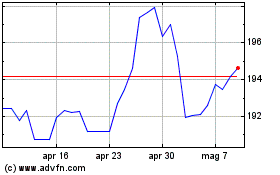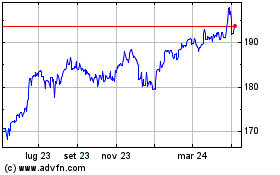Antipodean Currencies Slide Amid Risk Aversion, Geopolitical Tension Spike
19 Aprile 2024 - 4:42AM
RTTF2
Antipodean currencies such as Australia, the New Zealand and the
Canadian dollars weakened against other major currencies in the
Asian session on Friday, as Asian stock markets traded lower amid
ongoing concerns over the tensions in the middle-east with reports
of Israel retaliating to last weekend's attacks.
Israeli missiles targeted a site in Isfahan province in Iran,
raising fears of a widening conflict across the Middle East.
However, Iran's state-run media reported that there was no
missile attack and the explosions heard in Isfahan were the result
of the activation of the missile defenses.
Weakness across most sectors led by mining and energy stocks,
also led to the downturn of investor sentiment.
Interest rates continued to weigh on markets as the U.S. Fed is
now widely expected to hold off on cutting rates until at least
July.
Meanwhile, Minneapolis Fed President Neel Kashkari called for
patience in rate reductions, saying the first move may not take
place until 2025.
In the Asian trading now, the Australian dollar fell to 1-month
lows of 1.6683 against the euro and 97.78 against the yen, from
yesterday's closing quotes of 1.6573 and 99.27, respectively. If
the aussie extends its downtrend, it is likely to find support
around 1.68 against the euro and 96.00 against the yen.
Against the U.S., the Canada and the New Zealand dollars, the
aussie slipped to more than a 5-month low of 0.6362, more than a
2-month low of 0.8782 and a 2-day low of 1.0859 from yesterday's
closing quotes of 0.6420, 0.8837 and 1.0874, respectively. The
aussie may test support near 0.62 against the greenback, 0.86
against the loonie and 1.07 against the kiwi.
The NZ dollar fell to nearly a 6-month low of 0.5852 against the
U.S. dollar and nearly a 3-month low of 89.96 against the yen, from
yesterday's closing quotes of 0.5901 and 91.25, respectively. On
the downside, 0.57 against the greenback and 88.00 against the yen
are seen as the next support levels for the kiwi.
Against the euro, the kiwi slid to a 5-month low of 1.8135 from
Thursday's closing value of 1.8027. The next possible downside
target for the kiwi is seen around 1.84 region.
Meanwhile, the safe-have currencies such as the yen and the
Swiss franc advanced against their major rivals amid risk
aversion.
The yen rose to a 4-day high of 163.02 against the euro and a
1-week high of 190.31 against the pound, from yesterday's closing
quotes of 164.57 and 192.28, respectively. If the yen extends its
uptrend, it is likely to find resistance around 158.00 against the
euro and 185.00 against the pound.
Against the U.S. and the Canadian dollars, the yen advanced to
4-day highs of 153.59 and 111.27 from Thursday's closing quotes of
154.63 and 112.30, respectively. The yen is likely to find
resistance around 150.00 against the greenback and 110.00 against
the loonie.
The Swiss franc rose to nearly a 2-week high of 0.9012 against
the U.S. dollar, from an early 2-day low of 0.9127. The franc is
likely to find resistance around the 0.88 region.
Against the euro, the pound and the yen, the franc advanced to
nearly a 1-1/2-month high of 0.9566, nearly a 2-month high of
1.1171 and nearly a 1-month high of 170.72 from Thursday's closing
quotes of 0.9707, 1.1342 and 169.46, respectively. If the franc
extends its uptrend, it is likely to find resistance around 0.95
against the euro, 1.10 against the pound and 172.00 against the
yen.
Looking ahead, U.S. Baker Hughes oil rig count data is due to be
released in the New York session.
Grafico Cross Sterling vs Yen (FX:GBPJPY)
Da Apr 2024 a Mag 2024

Grafico Cross Sterling vs Yen (FX:GBPJPY)
Da Mag 2023 a Mag 2024
